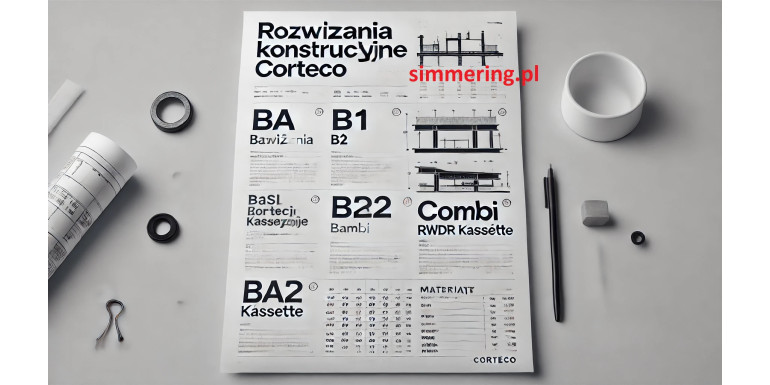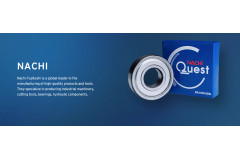
Construction Codes of Corteco Shaft Seals: A Comprehensive Guide
Introduction: The Importance of Choosing the Right Seals
Shaft seals, commonly known as simmerings, are vital components that ensure the sealing of rotating shafts in machines and equipment. They protect systems from fluid leakage and prevent contaminants from entering the mechanism, ensuring the longevity and efficiency of the machinery. Corteco, a part of the Freudenberg Group, has been providing high-quality seals for various applications in both the automotive and industrial sectors. Understanding the coding system for Corteco shaft seals, which indicates their dimensions, materials, and structural features, is crucial for selecting the right seal for specific applications.
1. Construction Codes of Corteco Seals
Corteco shaft seals are labeled with letter codes that describe their design and additional features. Each of these codes corresponds to a specific structure, which helps in selecting the right seal for particular conditions.
Types of Corteco Shaft Seals:
-
BA = SC
Features an outer surface coated with rubber, ensuring tightness under both positive pressure and vacuum conditions. Ideal for split housings and lightweight metal enclosures. Maximum pressure: up to 0.05 MPa. -
B1 = SB = SB2
Shaft seals with a metallic outer surface, designed for applications with high forces that could displace the seal from its housing. Maximum pressure: up to 0.05 MPa. -
B2 = SA2
Metallic outer surface with additional housing reinforcement, used for larger-sized seals. -
BASL = TC, B1SL = TB2, B2SL = TA2
These designs are similar to the BA type but include an additional dust lip that protects the main sealing lip from contaminants. This feature is essential in dusty environments. -
BAB = BABSL = TCV
Solutions used for very narrow seals that are resistant to higher pressures than 0.05 MPa. -
RWDR Kassette
A more complex cassette seal design that integrates a sealing ring with a counter-face, providing enhanced protection against contaminants and extending the seal's life. -
Combi
Multi-component seals made from various materials, designed for applications with high dust levels or where linear motion is involved.
Additional Structural Codes:
- ...RS... - Left-handed helix
- ...RD... - Right-handed helix
- ...DRW... - Bi-directional helix
- ...X6... - Reinforced dust lip
- ...X7... - Additional external sealing
2. Corteco Shaft Seal Dimensions
Corteco shaft seals are labeled in the format: [inner diameter] x [outer diameter] x [width]. For example, a seal labeled 45x72x10 has an inner diameter of 45 mm, an outer diameter of 72 mm, and a width of 10 mm. This labeling ensures precise selection of seals for specific shafts and housings, providing optimal sealing performance.
3. Seal Material: The Key to Performance
Choosing the right material for a shaft seal is crucial for meeting specific operational conditions, such as temperature, type of fluid, pressure, and exposure to chemicals. Corteco offers seals made from various materials, each suited for different environments:
-
NBR (Nitrile Butadiene Rubber)
A standard material resistant to mineral oils and greases, suitable for temperatures ranging from -30°C to +100°C. Ideal for standard applications. -
ACM (Polyacrylate Rubber)
Used in applications exposed to higher temperatures (from -25°C to +150°C), particularly in the automotive industry. -
FKM (Fluoroelastomer, Viton)
A high-performance material that can withstand temperatures up to 230°C, making it perfect for extreme chemical and thermal conditions. -
VMQ (Silicone Rubber)
Offers a wide temperature range, from -60°C to +200°C. Used in applications requiring flexibility and resistance to extreme temperatures. -
PTFE (Teflon)
Exceptionally resistant to high temperatures (from -200°C to +260°C) and chemicals, ideal for the most demanding conditions.
4. Example of Corteco Seal Labeling
Consider the Corteco seal 12016659 FPM B1BARDX7 35x50x7:
- 12016659 - Catalog number.
- FPM - Material (Fluoroelastomer, Viton).
- B1 - Construction with a metallic outer surface.
- BARD - Right-handed helix.
- X7 - Additional external sealing.
- 35x50x7 - Dimensions: inner diameter 35 mm, outer diameter 50 mm, width 7 mm.
5.Corteco: A Leader in Sealing Technology
Corteco offers a wide range of products, providing solutions for the most challenging working conditions. Engineers and technicians can rely on their products, regardless of application requirements, from automotive to industrial sectors. Each seal is designed with durability and optimal performance in mind, ensuring long-lasting reliability.
Conclusion
Understanding the coding system of Corteco shaft seals, including their dimensions, materials, and structural features, is crucial for selecting the appropriate seal that ensures optimal sealing performance and long service life. With a wide variety of products, from standard to specialized solutions, Corteco remains a leader in the sealing industry, offering high-quality solutions for a broad range of applications.




Leave a Reply Cancel Reply